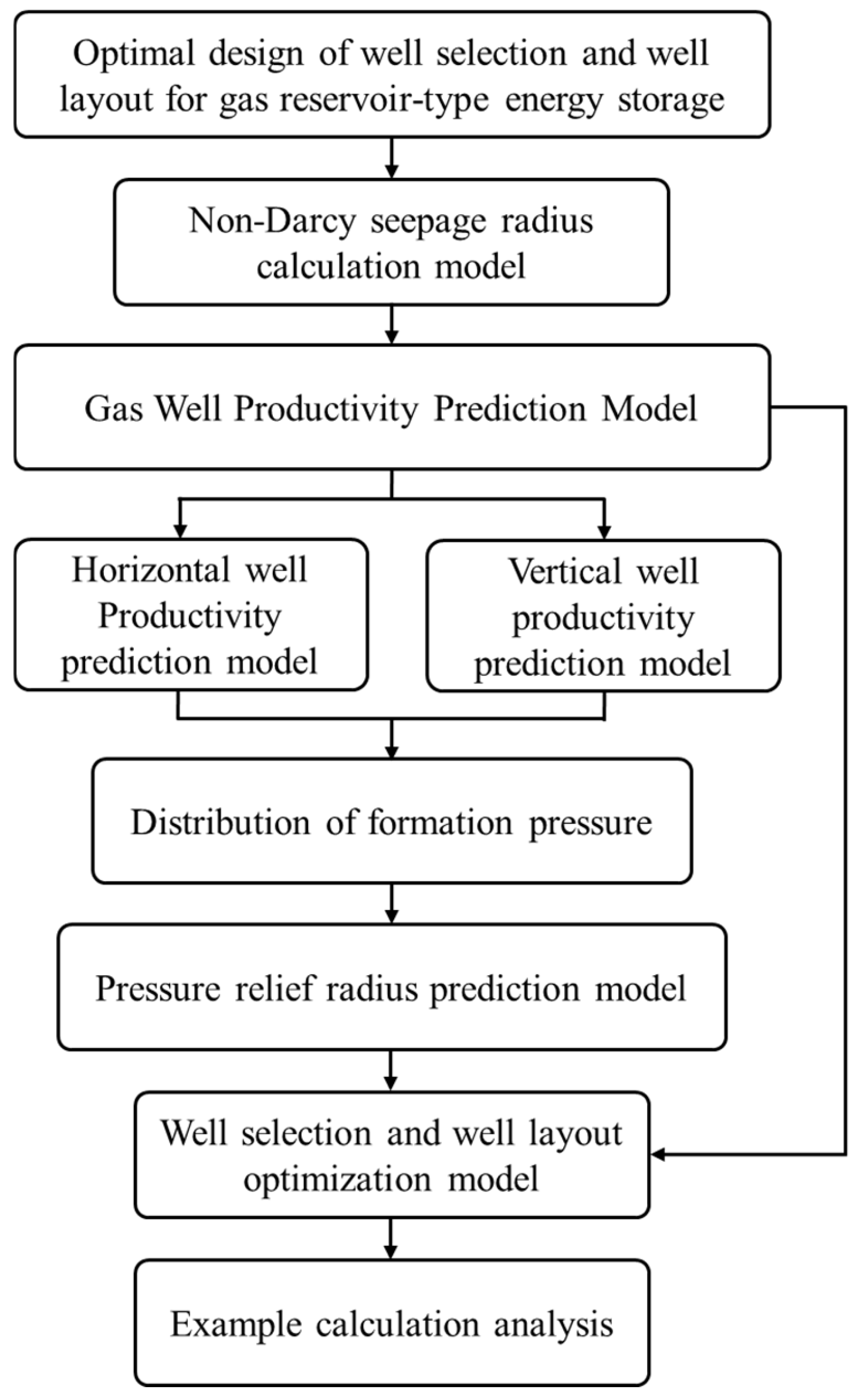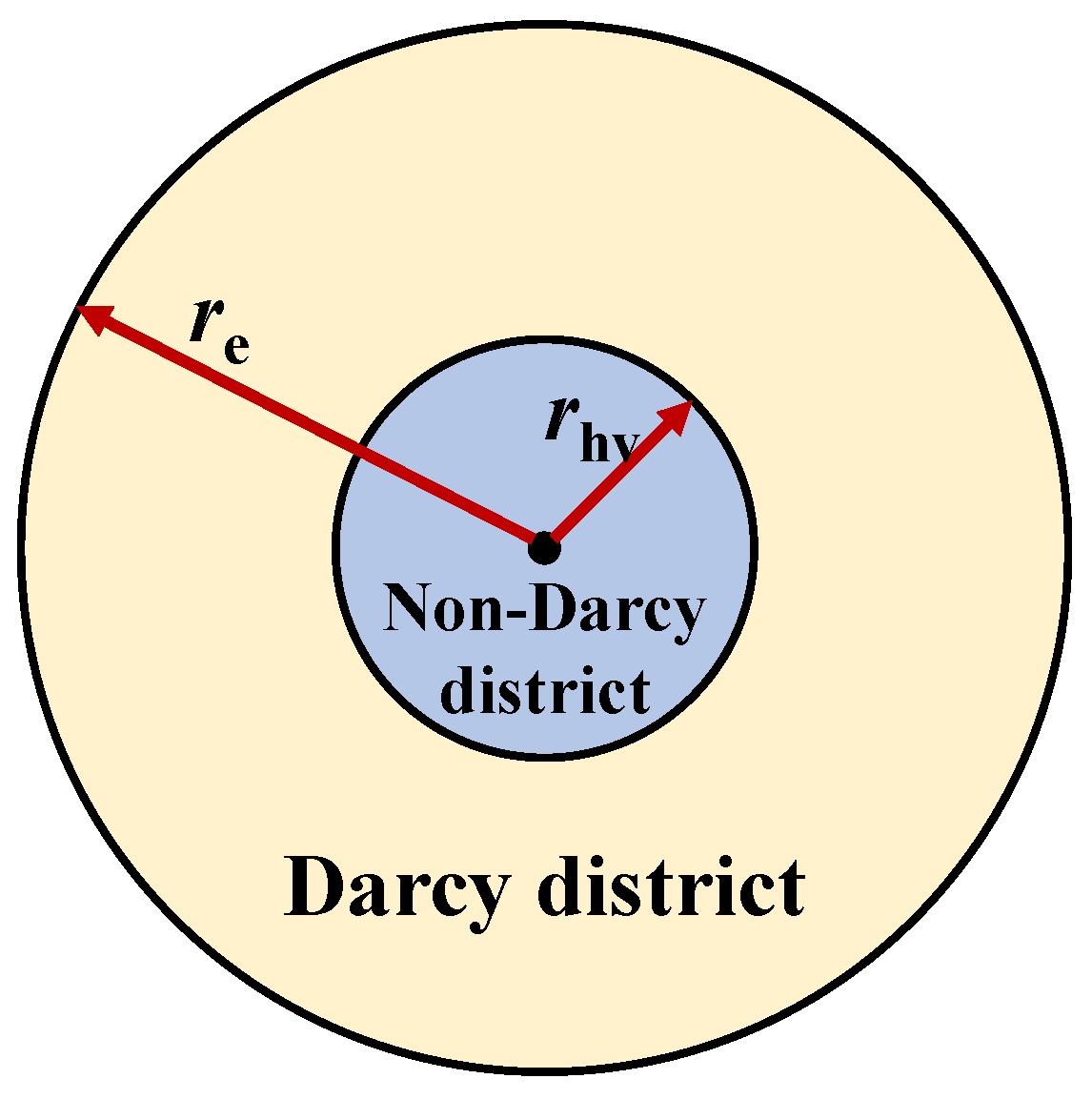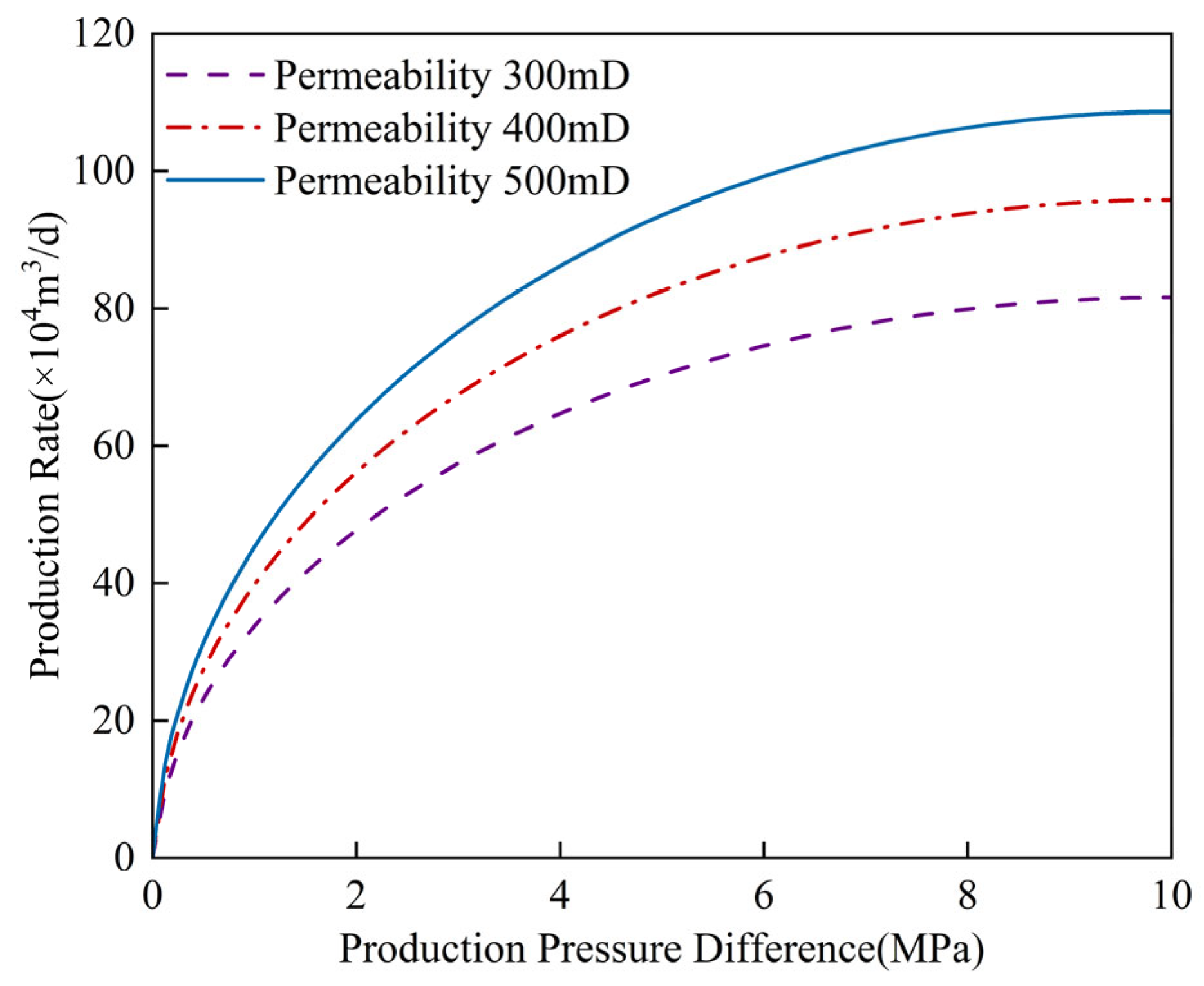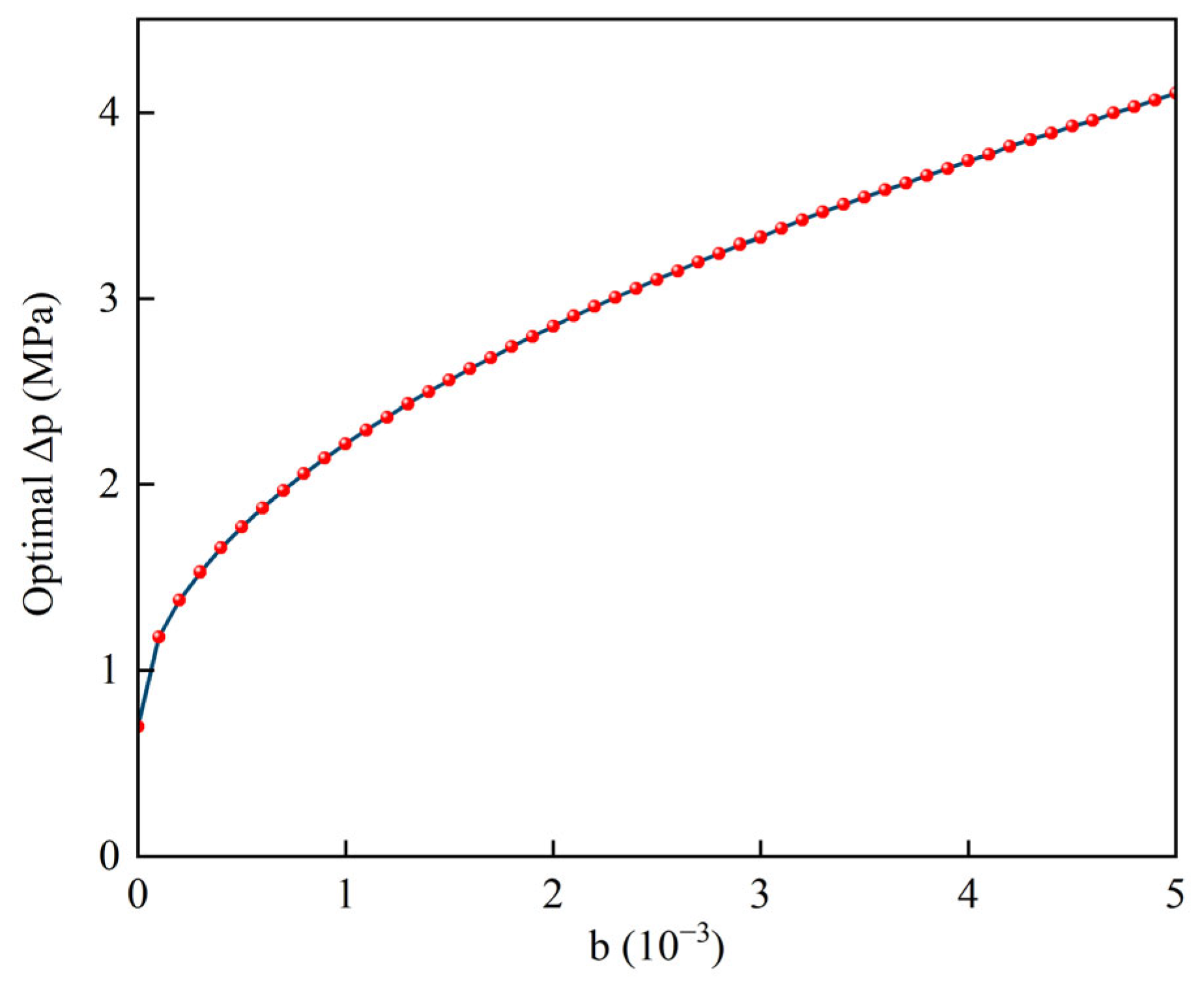5.2.1. Determination of the Deflation Radius
Based on the non-Darcy flow radius model, the variations in non-Darcy flow radii for vertical and horizontal wells with respect to production pressure differential are presented in
Figure 13.
It can be observed that the non-Darcy flow radius increases with the production pressure differential. At a production pressure differential of 1 MPa, the non-Darcy flow radii are 28.4 m for vertical wells and 43.3 m for horizontal wells. Based on these non-Darcy flow radii, the pressure (exp(p
2)) distribution derived from this analysis is illustrated in
Figure 14.
The analysis reveals that pressure dissipation primarily occurs near the wellbore. This arises from two factors: the reduced flow area and increased flow resistance in proximity to the wellbore, coupled with the additional pressure drop caused by high-velocity non-Darcy flow near the wellbore, which further amplifies pressure dissipation. Using the drainage radius calculation model (with for this gas reservoir), the calculated drainage radii are for vertical wells and for horizontal wells.
5.2.2. Analysis of Influencing Factors of Well Pattern Optimization Function
Within the same region, while reservoir heterogeneity varies, the average permeability of the reservoir remains constant. Under the exponential permeability model, the average permeability of the reservoir is expressed as:
Equations (4) and (31) can be obtained simultaneously:
Therefore, the intensity of reservoir heterogeneity is governed by the permeability coefficient
. As given by Equation (33), the relationship between the quantitative measure of well pattern optimization effectiveness (
), the number of horizontal wells, and the permeability coefficient
can be expressed as:
To maximize the well pattern optimization function under varying production pressure differentials, adjustments are made by controlling the permeability coefficient and varying the number of horizontal wells. Using a step size of and a permeability coefficient interval of , the relationship between reservoir heterogeneity (characterized by ) and the optimization function is plotted, as shown in the figure below.
As shown in
Figure 15,
decreases as
increases, that is,
decreases as reservoir heterogeneity increases, and the rate of decrease slows down as reservoir heterogeneity increases. The stronger the reservoir heterogeneity, the more significant the permeability difference. The high permeability zone is prone to form a dominant seepage channel, which leads to faster fluid velocity, while the low permeability area is difficult to effectively mobilize due to the large flow resistance. Overall, the interlayer interference is aggravated, resulting in a decrease in the overall seepage efficiency, and the value of the well pattern optimization function also decreases. When reservoir heterogeneity is low, it has a greater impact on seepage efficiency. As heterogeneity increases, this impact gradually diminishes, and thus the rate at which
decreases also slows down. It can be preliminarily seen from the figure that when the permeability coefficient b is between
and
, the optimal production pressure difference is about 1 MPa; when the permeability coefficient b is between
and
, the optimal production pressure difference is about 2.5 MPa; when the permeability coefficient b is between
and
, the optimal production pressure difference is about 4 MPa; the optimal production pressure difference increases with the increase in reservoir heterogeneity.
From Equation (34), we can see that the relationship between the value w that quantitatively represents the effect of well pattern optimization and the number of horizontal wells and production pressure difference is:
Under different reservoir heterogeneities, the maximum value of the well pattern optimization function is obtained by controlling the production pressure difference and changing the number of horizontal wells. Therefore, is taken as a step size, and the production pressure difference interval is 5 MPa. The relationship between the production pressure difference and the optimization function under different reservoir heterogeneities is plotted as shown in the figure.
As shown in
Figure 16,
first increases and then decreases with the production pressure difference, reaching a maximum value at a certain point, which is the optimal production pressure difference. When the production pressure difference is small, the production pressure difference can increase the single well production capacity and increase
, indicating that the production capacity is the main factor affecting the well pattern optimization function at this time. In this stage, with the increase in the production pressure difference, the gas flow rate and transmission efficiency increase. This increase improves the effective utilization rate of the gas reservoir and the well pattern optimization function, making the optimization function value gradually increase. When the production pressure difference is large, the gas leakage area and energy cost increase with the increase in the production pressure difference, causing
to decrease, indicating that the gas leakage area and energy cost are the main factors affecting the well pattern optimization function at this time. The energy consumption is large at this stage, and excessive pressure difference may make the gas flow unstable, which is not conducive to the overall well network optimization. In actual production, it should be controlled at the optimal production pressure difference.
In this way, combined with the impact of reservoir heterogeneity on productivity, the optimal production pressure difference under different reservoir heterogeneity conditions is plotted as shown in
Figure 17.
As shown in the figure, the optimal production pressure differential increases with increasing reservoir heterogeneity. The stronger the heterogeneity, the lower the single-well productivity and the greater the production pressure differential required to achieve the optimal well pattern. Without considering reservoir heterogeneity, the optimal production pressure differential is approximately 0.7 MPa. This figure can be used to determine the optimal production pressure differential that satisfies the well pattern optimization criteria for reservoirs with different degrees of heterogeneity.
5.2.3. Well Pattern Optimization Results
According to
Figure 16, the optimal production pressure difference in the compressed air energy storage reservoir in the depleted gas reservoir of the Mabei 8 block is 2.5 MPa. According to the above formula, the relationship between the number of horizontal wells N and the number of vertical wells M in the gas reservoir is shown in
Table 6.
According to the flow chart, the curve of the optimization function changing with the number of horizontal wells N is shown in
Figure 18.
As shown in the figure, the optimization function exhibits non-smooth and multi-peaked characteristics. This behavior arises from the discrete nature of the numbers of horizontal and vertical wells, as well as from the nonlinear coupling between non-Darcy flow and inter-well interference. When the number of wells exceeds a critical threshold, the drainage radii of adjacent wells begin to overlap, causing abrupt changes in the effective drainage area and leading to discrete jumps in the optimization function.
To ensure the reliability of the obtained optimum, a full-grid enumeration of well-number combinations was adopted to determine the global optimal configuration. The search was performed up to 12 horizontal wells, which represents the upper limit considered in this study. Specifically, when the number of horizontal wells is within the ranges of 0–2, 3–7, and 8–11, the optimization function decreases with increasing well number, while it increases in the ranges of 2–3, 7–8, and 11–12. The maximum value of the optimization function occurs when there are 3 horizontal wells. According to
Table 6, this corresponds to 23 vertical wells, indicating that a well pattern consisting of three horizontal and 23 vertical wells provides the optimal configuration for the depleted-gas-reservoir-based CAES system in the Mabei 8 block.
The optimized well configuration presents a practical and scalable layout for CAES systems in depleted gas reservoirs. In this arrangement, vertical wells primarily function as injection–production conduits, facilitating uniform pressure distribution and efficient air displacement throughout the reservoir. Horizontally drilled wells, strategically located within zones of higher permeability, further enhance gas deliverability and reduce non-Darcy flow losses near the wellbore, thereby improving the overall operational efficiency of the system.
























